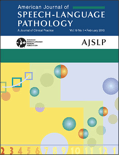
AMERICAN JOURNAL OF SPEECH-LANGUAGE PATHOLOGY
Scope & Guideline
Connecting Research, Practice, and Education in Communication Health
Introduction
Aims and Scopes
- Communication Disorders Research:
The journal publishes studies on a wide range of communication disorders, including aphasia, stuttering, dysarthria, and developmental language disorders, employing various research methodologies such as randomized controlled trials, qualitative studies, and systematic reviews. - Augmentative and Alternative Communication (AAC):
There is a significant emphasis on AAC strategies, technologies, and interventions for individuals with complex communication needs, reflecting the journal's commitment to inclusivity and accessibility in communication. - Cultural and Linguistic Diversity:
The journal highlights research that addresses cultural and linguistic diversity in speech-language pathology, recognizing the importance of culturally responsive practices and the unique needs of multilingual populations. - Intervention and Rehabilitation Strategies:
It publishes innovative intervention strategies for various speech and language disorders, including evidence-based practices for rehabilitation in clinical settings, focusing on practical applications for clinicians. - Telepractice and Technology Integration:
The journal explores the integration of technology and telepractice in speech-language therapy, particularly in response to the COVID-19 pandemic, offering insights into remote assessment and intervention.
Trending and Emerging
- Telepractice and Remote Interventions:
The rise of telepractice as a critical component of speech-language pathology has led to an increase in research focusing on remote assessment and intervention strategies, particularly in response to the challenges posed by the COVID-19 pandemic. - Cultural Competence and Equity in Practice:
There is a growing emphasis on cultural competence and equity in speech-language pathology, with research exploring how to address disparities in service provision and enhance the effectiveness of interventions for diverse populations. - Neuroscience and Communication Disorders:
Emerging research is increasingly integrating neuroscience principles to understand the underlying mechanisms of communication disorders, leading to more targeted and effective treatment strategies. - Focus on Mental Health and Communication:
There is a rising interest in the intersection of mental health and communication disorders, with studies exploring how psychological factors influence speech and language outcomes and how to incorporate mental health support into therapy. - Interdisciplinary Collaboration:
The importance of interdisciplinary collaboration in managing complex communication disorders is gaining traction, with studies highlighting the benefits of coordinated care among speech-language pathologists and other healthcare professionals.
Declining or Waning
- Traditional Speech Assessment Methods:
There is a noticeable decline in studies focusing exclusively on traditional assessment methods for speech and language disorders, as the field shifts towards more dynamic and integrated approaches that account for cultural and contextual factors. - Generalized Intervention Approaches:
Research on generalized or one-size-fits-all intervention strategies is decreasing, as there is a growing recognition of the need for personalized and context-specific treatment options tailored to individual patient needs. - Focus on Adult Populations:
The journal has seen a reduction in publications exclusively targeting adult communication disorders, with a noticeable shift towards pediatric populations and early intervention strategies, reflecting changing priorities in speech-language pathology. - Basic Research without Clinical Application:
There is a decline in purely theoretical or basic research studies that do not have direct clinical applications, as the journal increasingly emphasizes research that translates into practice and improves patient outcomes.
Similar Journals
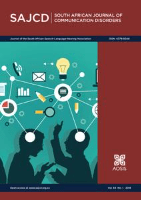
SOUTH AFRICAN JOURNAL OF COMMUNICATION DISORDERS
Innovating Solutions for Communication DisordersSOUTH AFRICAN JOURNAL OF COMMUNICATION DISORDERS, published by AOSIS, is a prominent peer-reviewed journal dedicated to advancing research in communication disorders. With its ISSN 0379-8046 and E-ISSN 2225-4765, this open-access journal has been providing a platform for innovative research since 2010, facilitating the dissemination of knowledge within the South African context and beyond. Its scope encompasses various fields, achieving notable rankings such as Q1 in Linguistics and Language and Q2 in Communication for 2023, highlighting its strong commitment to quality research. The journal has successfully converged its publication years from 1977 to 2024, reflecting its longstanding contribution to the discipline. Researchers and professionals in fields such as cognitive neuroscience, linguistics, and speech and hearing will find this journal an invaluable resource for staying ahead of current trends and developments. As it continuously seeks to bridge gaps in communication disorder research, the journal aims to foster collaboration and innovation within the academic community.
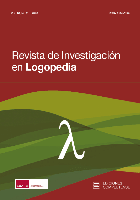
Revista de Investigacion en Logopedia
Elevating research standards in the field of logopedia.Revista de Investigacion en Logopedia is a premier open-access journal published by Universidad de Castilla-La Mancha, dedicated to advancing research in the fields of linguistics, language studies, and speech pathology. Since its inception in 2011, this journal has provided a platform for researchers and professionals to share innovative findings, contributing significantly to the development of the speech and hearing disciplines. With an impressive Q2 ranking in Linguistics and Language and a prominent Q4 ranking in Speech and Hearing for 2023, it sits at the confluence of academic research and practical application. Additionally, it has achieved commendable Scopus rankings, indicating its impact and relevance in the academic community. Open-access from the beginning, this journal ensures that its valuable content is accessible to a broader audience, promoting collaboration and knowledge sharing across international borders. Whether you're a researcher, a clinician, or a student, Revista de Investigacion en Logopedia is an essential resource for staying updated with the latest developments and insights in logopedia.

CoDAS
Advancing interdisciplinary dialogue in speech and hearing sciences.CoDAS, an esteemed academic journal published by the SOC BRASILEIRA FONOAUDIOLOGIA, serves as a leading platform for interdisciplinary research within the realms of linguistics, speech, and hearing sciences. Established as an Open Access journal in 2013, it ensures broad dissemination and accessibility of scholarly work, significantly benefitting researchers, clinicians, and students alike. Based in Brazil, CoDAS has garnered credibility with its impressive Q2 ranking in Linguistics and Language, as well as its rankings in Otorhinolaryngology and Speech and Hearing categories, reflecting its substantial contribution to these fields. The journal's impact is underscored by its robust Scopus rankings, including the 67th percentile in Language and Linguistics. With a commitment to fostering innovative research and bridging gaps between theory and practice, CoDAS continues to play a vital role in advancing knowledge and clinical practices in communication disorders and auditory sciences.
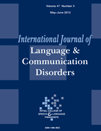
INTERNATIONAL JOURNAL OF LANGUAGE & COMMUNICATION DISORDERS
Exploring the Complexities of Communication DisordersWelcome to the INTERNATIONAL JOURNAL OF LANGUAGE & COMMUNICATION DISORDERS, a premier publication dedicated to advancing knowledge and research in the fields of linguistics, language, and communication disorders. Published by WILEY, this esteemed journal boasts an impressive impact, ranking Q1 in the Linguistics and Language category and Q2 in Speech and Hearing according to the 2023 category quartiles. The journal features rigorous peer-reviewed articles that address the complexities of language and communication, contributing significantly to both academic pursuits and clinical practices. With coverage spanning from 1966 to 2024, the journal reflects a rich history of scholarship and innovation. Research featured here ranks among the top in its field, evidenced by its strong placements in Scopus rankings: 89th percentile in Language and Linguistics and 73rd percentile in Speech and Hearing. As an essential resource for researchers, professionals, and students, this journal provides diverse access options, fostering a vibrant academic community dedicated to exploring the intricacies of communication disorders.
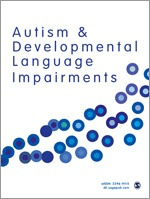
Autism & Developmental Language Impairments
Connecting academia and practice for transformative outcomes.Autism & Developmental Language Impairments is a pioneering peer-reviewed journal published by SAGE Publications Inc that focuses on advancing the understanding of autism spectrum disorders and language impairments across the developmental spectrum. Since its inception in 2016, this open access journal has provided a platform for researchers, practitioners, and educators to disseminate innovative research findings, clinical practices, and theoretical insights, reaching a global audience. The journal is notably indexed in prestigious databases and has established its credibility with a remarkable Rank of Q2 in both Clinical Psychology and Developmental and Educational Psychology as of 2023, solidifying its importance in these vital fields. Based in the United Kingdom, it addresses crucial issues in mental health, reflecting a commitment to fostering advancements that seek to enhance the lives of individuals affected by developmental language impairments. As it converges into its next phase from 2016 to 2024, Autism & Developmental Language Impairments continues to play an essential role in bridging gaps between academia and practice, making it an invaluable resource for researchers, clinicians, and students dedicated to this critical area of study.
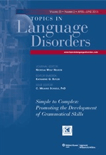
TOPICS IN LANGUAGE DISORDERS
Transforming insights into impactful interventions.TOPICS IN LANGUAGE DISORDERS is a premier academic journal published by LIPPINCOTT WILLIAMS & WILKINS that has been at the forefront of research in linguistics and communication sciences since 1980. Issued in both print (ISSN: 0271-8294) and electronic formats (E-ISSN: 1550-3259), this journal caters to an audience of researchers, clinicians, and students dedicated to understanding and addressing language disorders. With a notable impact factor and categorized in Q1 for Linguistics and Language and Q2 for Speech and Hearing in 2023, it occupies a vital niche in the scholarly discourse around language pathology, presenting rigorously peer-reviewed articles that advance knowledge and practice in the field. Although it is not an open access journal, subscribers benefit from in-depth studies, comprehensive reviews, and case analyses that drive innovation and inform evidence-based interventions. The journal aims to bridge theoretical insights and practical applications, making it an essential resource for professionals seeking to enhance their understanding of communication disorders and develop effective treatment strategies. Positioned in Philadelphia, PA, the journal continues to influence the landscape of language research, maintaining a critical role in nurturing the academic pursuit of excellence in language disorder studies.
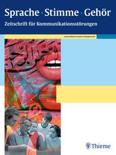
SPRACHE-STIMME-GEHOR
Advancing the Dialogue in Speech and Hearing.SPRACHE-STIMME-GEHOR is an esteemed academic journal published by GEORG THIEME VERLAG KG since 1980, focusing on the intersection of applied psychology, psychiatry, and speech and hearing. With an ISSN of 0342-0477 and E-ISSN 1439-1260, this journal serves as a vital resource for researchers, clinicians, and students dedicated to advancing knowledge and practice in these fields. Although currently not an open access journal, its rigorous peer-review process ensures the publication of high-quality research and clinical studies. In the 2023 Scopus ranking, it holds a position in the fourth quartile in relevant categories such as Applied Psychology and Speech and Hearing, illustrating its niche yet important role within the scientific community. The journal, based in Stuttgart, Germany, offers insights into innovative therapeutic approaches, evidence-based practice, and the latest trends, making it an essential read for professionals striving to enhance their understanding and impact in speech and hearing disciplines.
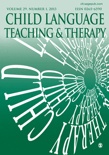
Child Language Teaching & Therapy
Empowering educators and clinicians in child language development.Child Language Teaching & Therapy is a premier journal published by SAGE Publications Ltd, dedicated to advancing the field of child language development and intervention. With its ISSN 0265-6590 and E-ISSN 1477-0865, this interdisciplinary journal has been pivotal since its inception in 1985 and continues to set academic standards through 2024. The journal holds a significant reputation within the Q3 quartile categories in Clinical Psychology, Developmental and Educational Psychology, and Education, alongside an esteemed Q1 designation in Linguistics and Language. Its Scopus rankings underscore its influence, particularly in the Arts and Humanities and Social Sciences domains, with remarkable percentiles that reflect its commitment to fostering high-quality research and innovation in child language teaching and therapy. Though not open access, it remains a vital resource for researchers, clinicians, and educators who seek to understand and enhance communication practices among children. By disseminating empirical studies, theoretical discussions, and practical applications, this journal plays a crucial role in bridging the gap between academic inquiry and real-world application, making it an indispensable asset for practitioners and scholars alike.
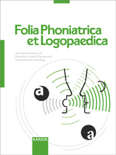
FOLIA PHONIATRICA ET LOGOPAEDICA
Pioneering Insights in Speech Therapy and Linguistic StudiesFOLIA PHONIATRICA ET LOGOPAEDICA, published by KARGER in Switzerland, stands as a premier journal in the fields of linguistics, phonetics, and speech therapy. With a rich history beginning in 1949 and spanning multiple decades, this esteemed journal has maintained a commitment to advancing research and scholarship in communication sciences, covering crucial topics relevant to both clinical practice and theoretical frameworks. Holding a prestigious Q1 ranking in Linguistics and Language, the journal also achieves high standings in related categories, with notable placements in Speech and Hearing and Nursing. Researchers, professionals, and students will find the insights and findings published within its pages to be invaluable for both academic pursuits and practical applications. Access options are available through traditional subscription models, enhancing its accessibility for dedicated scholars seeking to contribute to or expand their knowledge in this dynamic field.
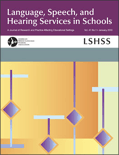
LANGUAGE SPEECH AND HEARING SERVICES IN SCHOOLS
Connecting research and practice for impactful educational outcomes.LANGUAGE SPEECH AND HEARING SERVICES IN SCHOOLS is a leading academic journal published by the American Speech-Language-Hearing Association, dedicated to advancing the fields of linguistics, speech, and hearing within the educational setting. With an ISSN of 0161-1461 and an E-ISSN of 1558-9129, this journal plays a pivotal role in disseminating peer-reviewed research that addresses critical issues faced by speech-language pathologists, educators, and researchers in schools. It has earned a distinguished reputation, ranking in the Q1 category for both Linguistics and Speech and Hearing in 2023, attesting to its impact and relevance in these fields. The journal seeks to publish original research, reviews, and evidence-based practices that improve speech and language services in educational contexts. Although it is not an open-access journal, it remains vital for professionals aiming to enhance communication disorders management in school environments. By bridging theoretical research and practical application, LANGUAGE SPEECH AND HEARING SERVICES IN SCHOOLS serves as an indispensable resource for advancing the scientific understanding of speech and language processing in educational settings.